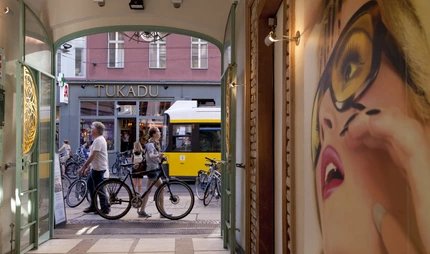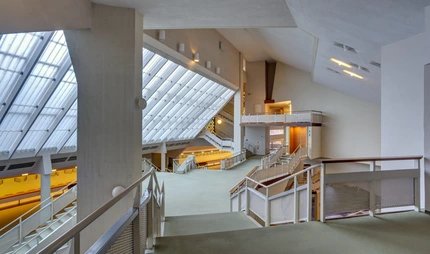
AEG am Humboldthain
Industrial Plant in the Electropolis Berlin
One of the largest industrial sites in Berlin is located in Mitte, between Brunnenstraße, Gustav-Meyer-Allee, Voltastraße and Hussitenstraße: the former site of electrical company "Allgemeine-Electricitäts-Gesellschaft“ (AEG) am Humboldthain.
One of the largest industrial sites in Berlin is located in Mitte, between Brunnenstraße, Gustav-Meyer-Allee, Voltastraße and Hussitenstraße: the former site of electrical company AEG am Humboldthain. Even if only parts of the former industrial complex have been preserved, there is still a sense of how important it once was. The listed site with the impressive assembly hall on Hussitenstraße demonstrates the importance of the electrical industry for the development of Berlin.
Berlin as Electropolis
It addition to mechanical engineering, it was the electrical industry that had a key influence on the industrial development of Berlin. The Berlin-based companies in the electrical industry gave rise to Berlin as an industrial metropolis after 1890. Indeed, Berlin became the electropolis! The rapid rise of the electrical industry was driven primarily by the electrical company AEG. In just a few years after starting in 1895, the company built a complex on Brunnenstraße that was enormous by the standards of the time: the factories of AEG am Humboldthain. These plants manufactured electrically-powered motors and machinery, railway equipment, electrical equipment and installation materials, as well as electronic household items of all kinds.
AEG am Humboldthain
The first buildings on the AEG site at Humboldthain were erected in the late nineteenth century, but the only surviving structure is what is named Beamtentor ("clerks' gate) designed by architect Franz Schwechten in 1896. The other buildings that remain standing were largely built to designs by architect Peter Behrens starting in 1910. They reflect fundamental changes in industrial architecture and paved the way for the history of twentieth-century architecture. Behrens developed a monumental style with strict, clearly ordered lines without any ornament. In addition to dark red brick, he also used bluish brick containing iron oxide on the façade which helped make the buildings stand out clearly from the surrounding residential area. One of the most impressive buildings on the former AEG site is the large machine assembly hall. Built in 1911/12 to plans by Peter Behrens, it is one of the largest factories of Berlin.
From AEG Site to Technology and Innovation Park
Electric devices continued to be produced in the factories on Brunnenstraße until 1983. After the site was abandoned, the buildings on the eastern half were demolished. The remaining factories are now used as the Technologie- und Innovationspark Berlin (TIP) by departments of the Technical University of Berlin, commercial enterprises and media companies. The entire facility is now listed.



